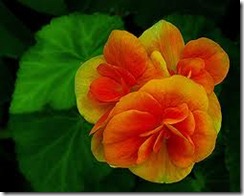There are three common types of begonias. Rex begonias are grown more for their colorful foliage than for flowers. Tuberous and wax begonias do have flowers. Some have large, interesting leaves and others have small glossy green or bronze leaves with flowers having a range of colors except blue. All begonias grown today are hybrids and methods of propagation vary per type.
Stem Cuttings
-
Wax begonias, angel wings and any begonia with a hairy leaf are suited to propagation by stem cutting. The optimal season to take cuttings is in spring, but any time during the growing season is fine. Take a shoot with at least two pairs of leaves. A node, or bump on the stem, should appear above each set of leaves. This is where the new plant will start. Trim the bottom of the stem just below the bottom set of leaves, then remove the bottom leaves. Insert the cutting in sterile planting medium with the node covered by the soil. Water and cover pot and all with a plastic bag to act as a mini-greenhouse. Cuttings will show growth when they root and the bag can be removed at that time.
Leaf Cuttings
-
Tuberous and Rex begonias, along with some wax varieties are propagated from leaf cuttings. Cut off a leaf with a portion of the stem, or petiole still attached. The petiole is what holds the leaf to the stem and it needs to be about 1/2 to 1 inch long. Cut large leaves, like angel begonias, around the edges to allow room to plant, but leave the main vein intact. Insert the leaf in moist sand with the petiole buried. Water, cover with a plastic bag and keep moist until the plant has rooted.
Root Cuttings or Division
-
Begonias that have roots contained in tubers, or a kind of bulb, propagate division. Wax begonias are not included in this method. It is important to divide in spring just when the buds on the tubers start to grow. Look for eyes on the tuber where growth will appear. These are slightly raised bumps on the surface of the top of the tuber. Cut the tuber with a sharp knife including one eye per section. Dust with powdered fungicide or powered charcoal to prevent disease and air-dry the cuttings two to three days. Use moist sand as a rooting medium and plant with eyes up.
Seed
-
Tuberous and wax Begonias are propagated by seed. Seeds must have a constant temperature of 70 degrees F and respond well to bottom seed heaters. Start in January by preparing a seed tray. Use sterile potting soil and moisten it by placing the filled tray in water so it soaks up from the bottom. Sprinkle the seeds on the surface and leave them uncovered by soil. Enclose the tray in a clear plastic bag, seal and place in an area that gets indirect light. The seeds will germinate in a week and when seedlings reach the bag, open it. Remove it in a few days. The seedlings tend to fall over, so many gardeners use a fan gently blowing so the plants stay up. Seedlings need more light or they grow leggy. Once two sets of true leaves appear, plant seedlings in there own pots until ready to plant outside.


Deprecated: strpos(): Passing null to parameter #1 ($haystack) of type string is deprecated in /home/agriviek8Qv/agriviet.net/public_html/wp-includes/comment-template.php on line 2522